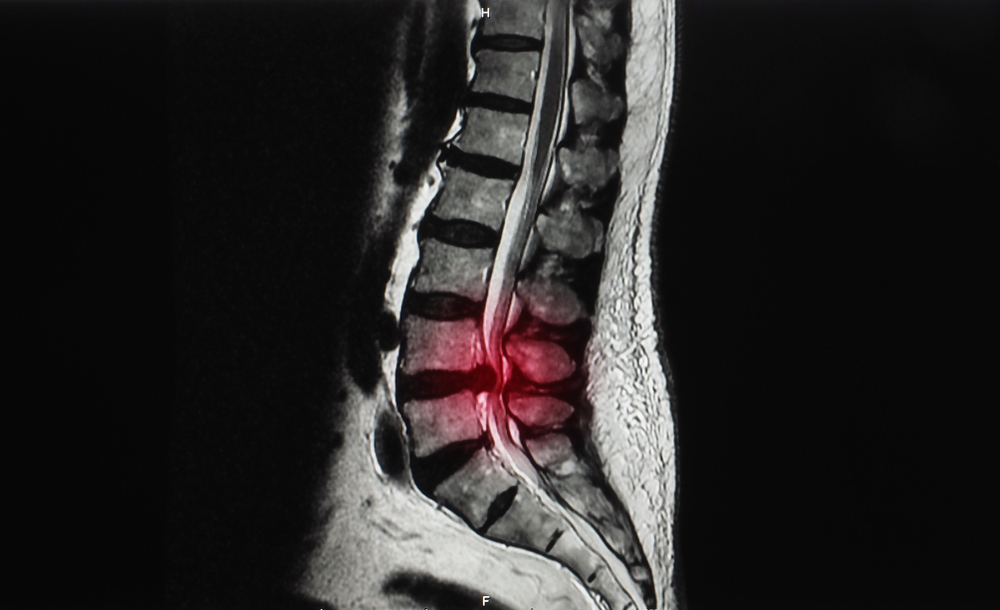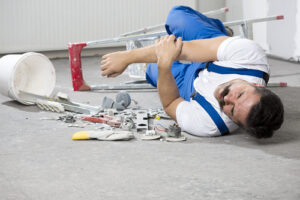Cauda Equina Syndrome

You’re a construction worker, spending your days building houses, offices, or roads. You work hard to support your family and take pride in your job. But one day, you experience a severe lower back injury on the job site. This is where an experienced Indianapolis construction site accident attorney can help you.
You think it’s just a pulled muscle, but as time goes on, you notice strange symptoms like numbness in your legs, difficulty walking, and even loss of bladder or bowel control. These could be signs of a serious condition called Cauda Equina Syndrome (CES).
Schedule a Free Initial Consultation Today!
What is Cauda Equina Syndrome?
Cauda Equina Syndrome is a rare but severe condition that affects the bundle of nerves at the lower end of the spinal cord, known as the cauda equina. These nerves control the lower limbs and pelvic organs, including the bladder and bowels.
These compressed or damaged nerves can cause a range of symptoms. If left untreated, they can permanently paralyze you.
Construction Workers at High Risk
Construction workers face a multitude of risks on the job site every day. One of the most significant dangers is the potential for developing CES.
This serious condition can occur as a result of the physically demanding nature of construction work, which often involves:
- Heavy lifting
- Repetitive movements
- Awkward positions that put excessive strain on the lower back
Over time, this constant wear and tear can lead to damage to the delicate bundle of nerves at the base of the spine, known as the cauda equina, resulting in a range of debilitating symptoms.
In addition to the cumulative effects of physical labor, construction workers are also at risk of sudden, traumatic injuries that can cause direct damage to the spine and lead to CES.

Falls from heights, such as from scaffolding or ladders, are a common occurrence on construction sites and can result in severe back injuries. Being struck by heavy equipment, such as cranes or bulldozers, can also cause blunt force trauma to the spine, potentially compressing or damaging the cauda equina nerves.
The alarming frequency of back injuries among construction workers underscores the magnitude of this risk.
According to the Bureau of Labor Statistics, construction workers experience one of the highest rates of back injuries across all occupations, with these injuries accounting for nearly 40% of all injuries in the construction industry.
To mitigate the risk of CES and other back injuries, it is crucial for construction companies to implement comprehensive safety training programs that educate workers on proper lifting techniques, body mechanics, and ergonomic best practices. Employers must also provide workers with appropriate safety equipment, such as back supports and fall protection gear, to help minimize the risk of injury.
Regular equipment maintenance and strict adherence to safety protocols, such as using machinery only for its intended purpose and within its designated capacity, are also essential for preventing accidents that can lead to CES.
Encouraging workers to report potential hazards, take breaks when needed, and listen to their bodies can go a long way in preventing overexertion and reducing the likelihood of injury.
When workers feel empowered to prioritize their safety and well-being, they are more likely to engage in practices that protect themselves and their colleagues from harm.
Despite the inherent risks of construction work, it is important to remember that many cases of Cauda Equina Syndrome are preventable with proper safety measures and a proactive approach to worker well-being.
By investing in comprehensive safety training, providing appropriate equipment, and cultivating a culture of safety on the job site, construction companies can protect their workers from this devastating condition and ensure a healthier, more productive workforce overall.
However, even with the strongest safety measures in place, accidents can still happen. When they do, construction workers must look for CES symptoms and seek immediate medical attention if they suspect it. Early diagnosis and treatment are critical for preventing permanent damage and improving outcomes for those with this condition.
If you develop Cauda Equina Syndrome because of a workplace injury, you need a lawyer who understands your rights and options for seeking workers’ compensation benefits. Navigating the complex workers’ compensation system, especially when dealing with a serious medical condition, requires an experienced attorney.
An attorney who handles workers’ compensation cases can explain your rights, gather necessary evidence, and fight for the benefits you need and deserve. With the right legal support, you can focus on your recovery and rehabilitation, knowing you have an advocate in your corner who is working tirelessly to protect your interests.
Symptoms to Watch For
Be aware of the symptoms of Cauda Equina Syndrome so you can seek immediate medical attention if needed.
Some of the most common symptoms include:
- Severe lower back pain
- Numbness or tingling in the legs, buttocks, or genital area
- Weakness in the legs
- Difficulty walking or standing
- Loss of bladder or bowel control
- Sexual dysfunction
These symptoms can develop gradually or come on suddenly after an injury. If you experience any of these symptoms, stop working and see a doctor right away. Early diagnosis and treatment can prevent permanent damage.
Diagnosis and Treatment
Diagnosing Cauda Equina Syndrome typically involves a physical exam, neurological tests, and imaging scans such as an MRI or CT scan. These tests can help determine the extent of the nerve damage and guide treatment decisions.
Treatment for CES usually involves emergency surgery to relieve the pressure on the nerves and prevent further damage. The sooner the surgery, the better the chances of a full recovery. In some cases, you may need physical therapy and rehabilitation to regain strength and function in the affected areas.
Workers’ Compensation Claims
If you develop Cauda Equina Syndrome as a result of a workplace injury, you may be entitled to workers’ compensation benefits. These benefits can cover your medical expenses, lost wages, and other related costs.
Reporting Your Injury
The first step in seeking workers’ compensation benefits is to report your injury to your employer as soon as possible. Most states have specific deadlines for reporting workplace injuries, so it’s important to act quickly. If you miss the deadline, you may lose your right to benefits.
Most states have specific deadlines for reporting workplace injuries, so it’s important to act quickly. If you miss the deadline, you may lose your right to benefits.
When reporting your injury, provide as much detail as possible about how and when the injury occurred, as well as any symptoms you experience. If possible, document the injury with photos or witness statements.
Medical Treatment
After reporting your injury, your employer should provide you with information about seeking medical treatment through their workers’ compensation insurance. Follow your doctor’s instructions. Attend all scheduled appointments to ensure proper treatment and documentation of your condition.
In some cases, your employer may require you to see a specific doctor or use a designated medical provider network. However, if you are not satisfied with your care, you may seek a second opinion or change providers.
Filing a Claim
Once you have reported your injury and begun receiving medical treatment, you will need to file a formal workers’ compensation claim. This typically involves completing specific forms and providing documentation of your injury and treatment.
Your employer’s insurance company will then review your claim and determine your eligibility for benefits. If your claim is approved, you will begin receiving benefits to cover your medical expenses and lost wages.
If your claim is denied, you have the right to appeal the decision. This is where an experienced Indianapolis workers’ compensation attorney can help you. A lawyer can gather evidence and build a strong case for why you deserve benefits.
Types of Benefits
Workers’ compensation benefits for Cauda Equina Syndrome may include:
- Medical expenses: This can include the cost of surgeries, medications, physical therapy, and other necessary treatments related to your condition.
- Temporary disability benefits: If your condition prevents you from working, you may be entitled to temporary disability benefits to help replace a portion of your lost wages while you recover.
- Permanent disability benefits: If your condition results in permanent impairment or limitations, you may be eligible for permanent disability benefits to compensate for your ongoing loss of earning capacity.
- Vocational rehabilitation: If your condition prevents you from returning to your previous job, you may be entitled to vocational rehabilitation services to help you train for a new position or career.
Navigating the System
Navigating the workers’ compensation system can be overwhelming, especially when you are dealing with a serious medical condition like Cauda Equina Syndrome. There are strict deadlines, complicated forms, and legal jargon to decipher.
An experienced workers’ compensation attorney can make a significant difference. An attorney can explain your rights, gather necessary evidence, and advocate for your interests throughout the claims process.
An attorney can also help you explore additional options for compensation, such as third-party claims against negligent parties other than your employer, or Social Security disability benefits if your condition is expected to last a year or more.
Don’t Go It Alone
Dealing with Cauda Equina Syndrome is challenging enough without also trying to navigate the complex workers’ compensation system on your own. If you have developed this condition because of a workplace injury, don’t hesitate to seek the guidance and support of an experienced attorney.
Remember, you have rights as an injured worker. You deserve to be compensated for the harm you have suffered. With the right legal support, you can focus on your recovery while your attorney fights for the benefits you need and deserve.
Damages Available for Cauda Equina Syndrome
If you develop CES as a result of a workplace injury, you may recover damages through a workers’ compensation claim or a third-party liability lawsuit. These damages compensate you for the losses you have suffered because of your condition, including medical expenses, lost wages, and pain and suffering.
One of the primary types of damages available to construction workers with CES is medical expenses. This can include the cost of emergency room visits, surgeries, medications, physical therapy, and any other necessary medical treatment related to the condition. In many cases, the medical expenses associated with CES can be substantial, particularly if you require ongoing care or multiple surgeries.
 In addition to medical expenses, construction workers with CES may also be entitled to compensation for lost wages. If the condition prevents you from being able to perform your job duties, you may receive temporary disability benefits through workers’ compensation. These benefits typically provide a percentage of your average weekly wage while you are unable to work.
In addition to medical expenses, construction workers with CES may also be entitled to compensation for lost wages. If the condition prevents you from being able to perform your job duties, you may receive temporary disability benefits through workers’ compensation. These benefits typically provide a percentage of your average weekly wage while you are unable to work.
If your CES results in permanent impairment or limitations, you may also be entitled to permanent disability benefits. These benefits are intended to compensate you for your ongoing loss of earning capacity and are typically calculated based on the severity of the impairment and your worker’s age, education, and job skills.
Other types of damages that may be available to construction workers with CES include loss of enjoyment of life, loss of consortium (if the condition has impacted your relationship with your spouse), and punitive damages (if the employer or third party’s conduct was particularly egregious).
Construction workers who have developed CES because of a workplace injury need an experienced attorney. An attorney can also help you navigate the legal process of pursuing a workers’ compensation claim or third-party liability lawsuit and ensure that you receive the maximum compensation possible for your losses.
The Road to Recovery
Recovering from Cauda Equina Syndrome can be a long and challenging process, both physically and emotionally. In addition to the physical symptoms, many people experience depression, anxiety, and other mental health challenges as they adapt to new limitations and chronic pain.
It’s important to have a strong support system during this time. Joining a support group for people with CES can be helpful in connecting with others who understand what you’re going through and sharing coping strategies.
Contact a Workers’ Compensation Attorney Today
If you or a loved one has developed Cauda Equina Syndrome as a result of a construction accident or workplace injury, don’t wait to seek help. Contact an experienced Indianapolis workers’ compensation attorney today to learn more about your rights and options for seeking the benefits and support you need to move forward.

